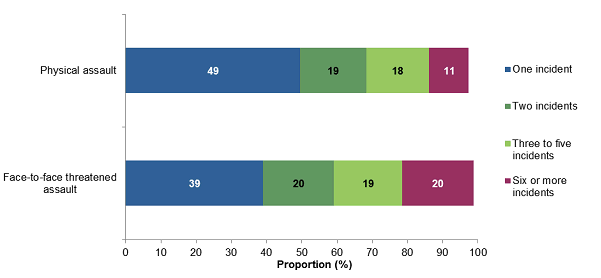MULTIPLE VICTIMISATION Endnote 1
PERSONS WHO EXPERIENCED MULTIPLE VICTIMISATION IN 2016-17 (Tables 9, 10 and 11)
Persons can experience multiple incidents of the same personal crime type within the 12 months prior to interview.
- Half (48%) of all persons aged 15 years and over who experienced physical assault experienced multiple incidents.
- Two in five (60%) persons aged 15 years and over who experienced face-to-face threatened assault experienced multiple incidents.
Of the selected personal crime types, persons who experienced robbery were the most likely to experience a single incident only. Over two-thirds (68%) of persons who experienced robbery experienced one incident only, compared with half (49%) of persons who experienced physical assault.
Experience of multiple incidents of personal crime, Australia, 2016-17(a)

Australian Bureau of Statistics
© Commonwealth of Australia 2018.
Footnote(s): (a) Data for robbery are not shown, as estimates of the number of persons experiencing multiple incidents of robbery in the 12 months prior to interview are subject to high sampling error (for further details refer to the Technical Note).
Source: Crime Victimisation, Australia
HOUSEHOLDS THAT EXPERIENCED MULTIPLE VICTIMISATION IN 2016-17 (Table 12)
In the 12 months prior to interview, households were more likely to experience one incident than multiple incidents for all household crime types. The proportion of households that experienced a single incident ranged from 93% for motor vehicle theft to 75% for break-in.
Experience of multiple incidents of household crime, Australia, 2016-17(a)

Australian Bureau of Statistics
© Commonwealth of Australia 2018.
Footnote(s): (a) Data for motor vehicle theft are not shown, as estimates of the number of households experiencing multiple incidents of motor vehicle theft in the 12 months prior to interview are subject to high sampling error (for further details refer to the Technical Note).
Source: Crime Victimisation, Australia
ENDNOTES
Endnote 1 All comparisons discussed have been tested for statistical significance with a 95% level of confidence that there is a real difference in the two populations being tested. Only data with a relative standard error (RSE) of less than 25% are referred to in the text of this publication and these estimates are considered sufficiently reliable for general use. To determine whether there is a statistical difference between any other two estimates, significance testing should be undertaken. For further information, refer to the Technical Note.
 Print Page
Print Page
 Print All
Print All
 Quality Declaration
Quality Declaration